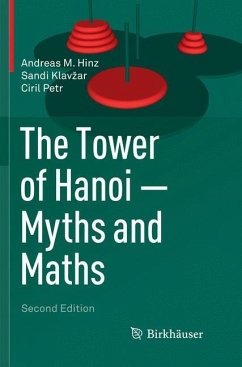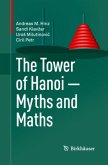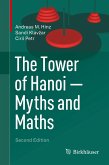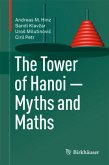The solitaire game "The Tower of Hanoi" was invented in the 19th century by the French number theorist Édouard Lucas. The book presents its mathematical theory and offers a survey of the historical development from predecessors up to recent research. In addition to long-standing myths, it provides a detailed overview of the essential mathematical facts with complete proofs, and also includes unpublished material, e.g., on some captivating integer sequences. The main objects of research today are the so-called Hanoi graphs and the related Sierpinski graphs. Acknowledging the great popularity of the topic in computer science, algorithms, together with their correctness proofs, form an essential part of the book. In view of the most important practical applications, namely in physics, network theory and cognitive (neuro)psychology, the book also addresses other structures related to the Tower of Hanoi and its variants.
The updated second edition includes, for the first time in English, the breakthrough reached with the solution of the "The Reve's Puzzle" in 2014. This is a special case of the famed Frame-Stewart conjecture which is still open after more than 75 years. Enriched with elaborate illustrations, connections to other puzzles and challenges for the reader in the form of (solved) exercises as well as problems for further exploration, this book is enjoyable reading for students, educators, game enthusiasts and researchers alike.
Excerpts from reviews of the first edition:
"The book is an unusual, but very welcome, form of mathematical writing: recreational mathematics taken seriously and serious mathematics treated historically. I don't hesitate to recommend this book to students, professional research mathematicians, teachers, and to readers of popular mathematics who enjoy more technical expository detail."
Chris Sangwin, The Mathematical Intelligencer 37(4) (2015) 87f.
"The book demonstrates that the Tower of Hanoi has a very rich mathematical structure, and as soon as we tweak the parameters we surprisingly quickly find ourselves in the realm of open problems."
László Kozma, ACM SIGACT News 45(3) (2014) 34ff.
"Each time I open the book I discover a renewed interest in the Tower of Hanoi. I am sure that this will be the case for all readers."
Jean-Paul Allouche, Newsletter of the European Mathematical Society 93 (2014) 56.
The updated second edition includes, for the first time in English, the breakthrough reached with the solution of the "The Reve's Puzzle" in 2014. This is a special case of the famed Frame-Stewart conjecture which is still open after more than 75 years. Enriched with elaborate illustrations, connections to other puzzles and challenges for the reader in the form of (solved) exercises as well as problems for further exploration, this book is enjoyable reading for students, educators, game enthusiasts and researchers alike.
Excerpts from reviews of the first edition:
"The book is an unusual, but very welcome, form of mathematical writing: recreational mathematics taken seriously and serious mathematics treated historically. I don't hesitate to recommend this book to students, professional research mathematicians, teachers, and to readers of popular mathematics who enjoy more technical expository detail."
Chris Sangwin, The Mathematical Intelligencer 37(4) (2015) 87f.
"The book demonstrates that the Tower of Hanoi has a very rich mathematical structure, and as soon as we tweak the parameters we surprisingly quickly find ourselves in the realm of open problems."
László Kozma, ACM SIGACT News 45(3) (2014) 34ff.
"Each time I open the book I discover a renewed interest in the Tower of Hanoi. I am sure that this will be the case for all readers."
Jean-Paul Allouche, Newsletter of the European Mathematical Society 93 (2014) 56.
"The Tower of Hanoi isn't just a recreational problem, it is also a substantial area worthy of study, and this book does this area full justice. ... I haven't enjoyed reading a 'popular mathematics' book as much for quite some time, and I don't hesitate to recommend this book to students, professional research mathematicians, teachers, and to readers of popular mathematics who enjoy more technical expository detail." (Chris Sangwin, The Mathematical Intelligencer, Vol. 37, 2015)
"This book takes the reader on an enjoyable adventure into the Tower of Hanoi puzzle (TH) and various related puzzles and objects. ... The style of presentation is entertaining, at times humorous, and very thorough. The exercises ending each chapter are an essential part of the explication providing some definitions ... and some proofs of the theorems or statements inthe main text. ... As such, the book will be an enjoyable read for any recreational mathematician ... ." (Andrew Percy, zbMATH, Vol. 1285, 2014)
"This research monograph focuses on a large family of problems connected to the classic puzzle of the Tower of Hanoi. ... The authors explain all the combinatorial concepts they use, so the book is completely accessible to an advanced undergraduate student. ... Summing Up: Recommended. Comprehensive mathematics collections, upper-division undergraduates through researchers/faculty." (M. Bona, Choice, Vol. 51 (3), November, 2013)
"The Tower of Hanoi is an example of a problem that is easy to state and understand, yet a thorough mathematical analysis of the problem and its extensions is lengthy enough to make a book. ... there is enough implied mathematics in the action to make it interesting to professional mathematicians. ... It was surprising to learn that the 'simple' problem of the Tower of Hanoi ... could be the subject of a full semester special topics course in advanced mathematics." (Charles Ashbacher, MAA Reviews, May, 2013)
"Gives an introduction to the problem and the history of the TH puzzle and other related puzzles, but it also introduces definitions and properties of graphs that are used in solving these problems. ... Thus if you love puzzles, and more in particular the mathematics behind it, this is a book for you. ... Also if you are looking for a lifelasting occupation, then you may find here a list of open problems that will keep you busy for a while." (A. Bultheel, The European Mathematical Society, February, 2013)
"This book takes the reader on an enjoyable adventure into the Tower of Hanoi puzzle (TH) and various related puzzles and objects. ... The style of presentation is entertaining, at times humorous, and very thorough. The exercises ending each chapter are an essential part of the explication providing some definitions ... and some proofs of the theorems or statements inthe main text. ... As such, the book will be an enjoyable read for any recreational mathematician ... ." (Andrew Percy, zbMATH, Vol. 1285, 2014)
"This research monograph focuses on a large family of problems connected to the classic puzzle of the Tower of Hanoi. ... The authors explain all the combinatorial concepts they use, so the book is completely accessible to an advanced undergraduate student. ... Summing Up: Recommended. Comprehensive mathematics collections, upper-division undergraduates through researchers/faculty." (M. Bona, Choice, Vol. 51 (3), November, 2013)
"The Tower of Hanoi is an example of a problem that is easy to state and understand, yet a thorough mathematical analysis of the problem and its extensions is lengthy enough to make a book. ... there is enough implied mathematics in the action to make it interesting to professional mathematicians. ... It was surprising to learn that the 'simple' problem of the Tower of Hanoi ... could be the subject of a full semester special topics course in advanced mathematics." (Charles Ashbacher, MAA Reviews, May, 2013)
"Gives an introduction to the problem and the history of the TH puzzle and other related puzzles, but it also introduces definitions and properties of graphs that are used in solving these problems. ... Thus if you love puzzles, and more in particular the mathematics behind it, this is a book for you. ... Also if you are looking for a lifelasting occupation, then you may find here a list of open problems that will keep you busy for a while." (A. Bultheel, The European Mathematical Society, February, 2013)







